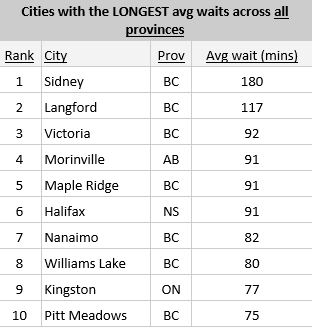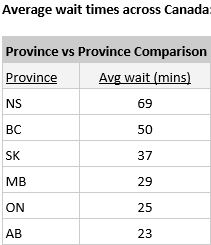With flu season in full swing, people across B.C. are waiting to see a doctor, any doctor — and new data shows some cities in the province are seeing some staggering wait times at walk-in clinics.

The data, collected by Medimaps, tracked clinic wait times in six provinces across the country: B.C., Alberta, Ontario, Manitoba, Saskatchewan and Nova Scotia.
B.C. was found to be in the second spot on the list, with an average wait time of 50 minutes (behind Nova Scotia’s 69 minutes), and seven of the top 10 cities with the highest wait times are in B.C.
Of those, three Vancouver Island municipalities — Sidney, Langford and Victoria — reportedly have patients waiting an hour-and-a-half or more to see a doctor. In Sidney, Medimaps says the average wait time is two hours, topping the national list.

Residents say it can be even longer.
“Sometimes you got to wait four hours,” one said. Others pointed to short operating hours and long lineups before clinics even open.

Medimaps says the data comes from its online clinic wait time index, which has access to wait time information for 70 per cent of all walk-in clinics in Canada. Those clinics update their wait times to the site every 30 minutes.
CEO Blake Adam says the wait times can be pinned to a shortage of doctors in B.C., which not only forces people without a family physician to seek care at walk-ins but also affects those who do have their own doctor.
While Vancouver Island is seeing the highest wait times, frustration is also high in the Lower Mainland. There, Maple Ridge is seeing an average wait of 91 minutes, while Pitt Meadows has an average of 75 minutes.

Get weekly health news
The rest of the top five — Coquitlam, Vancouver and Port Moody — have an average wait time of just under an hour.

Adam points out that B.C.’s average wait time is twice that of Ontario’s, at 25 minutes, despite cities in that province like Kingston, Barrie and Cambridge seeing waits of over 70 minutes.
Alberta’s average wait time is the lowest on the list, at 23 minutes.

Medimap’s data has not been released to the public or the provincial government, prompting Health Minister Adrian Dix to ask for a copy of the full report to take a deeper look at the numbers.
Dix did acknowledge roughly 750,000 British Columbians did not have a family doctor when the NDP took power in 2017, and said his ministry is continuing to work on lowering that number to zero.
“This is a significant situation and we’re taking action,” he said, citing the opening of dozens of primary care centres and networks, along with 200 new general practitioners hired.
“A lot of people need a doctor in B.C., a lot of people need a nurse practitioner, and we’re working hard to meet this challenge.”
—With files from John Hua





Comments